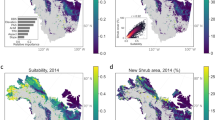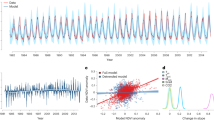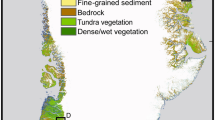Abstract
Climate warming has led to changes in the composition, density and distribution of Arctic vegetation in recent decades1,2,3,4. These changes cause multiple opposing feedbacks between the biosphere and atmosphere5,6,7,8,9, the relative magnitudes of which will have globally significant consequences but are unknown at a pan-Arctic scale10. The precise nature of Arctic vegetation change under future warming will strongly influence climate feedbacks, yet Earth system modelling studies have so far assumed arbitrary increases in shrubs (for example, +20%; refs 6, 11), highlighting the need for predictions of future vegetation distribution shifts. Here we show, using climate scenarios for the 2050s and models that utilize statistical associations between vegetation and climate, the potential for extremely widespread redistribution of vegetation across the Arctic. We predict that at least half of vegetated areas will shift to a different physiognomic class, and woody cover will increase by as much as 52%. By incorporating observed relationships between vegetation and albedo, evapotranspiration and biomass, we show that vegetation distribution shifts will result in an overall positive feedback to climate that is likely to cause greater warming than has previously been predicted. Such extensive changes to Arctic vegetation will have implications for climate, wildlife and ecosystem services.
This is a preview of subscription content, access via your institution
Access options
Subscribe to this journal
Receive 12 print issues and online access
$209.00 per year
only $17.42 per issue
Buy this article
- Purchase on SpringerLink
- Instant access to full article PDF
Prices may be subject to local taxes which are calculated during checkout



Similar content being viewed by others
References
Tape, K., Sturm, M. & Racine, C. The evidence for shrub expansion in Northern Alaska and the Pan-Arctic. Glob. Change Biol. 12, 686–702 (2006).
Goetz, S. J. et al. in Eurasian Arctic Land Cover and Land Use in a Changing Climate (eds Gutman, G. & Reissell, A.) 9–36 (Springer, 2011).
Elmendorf, S. C. et al. Plot-scale evidence of tundra vegetation change and links to recent summer warming. Nature Clim. Change 2, 453–457 (2012).
Macias-Fauria, M., Forbes, B. C., Zetterberg, P. & Kumpula, T. Eurasian Arctic greening reveals teleconnections and the potential for structurally novel ecosystems. Nature Clim. Change 2, 613–618 (2012).
Chapin, F. S. et al. Role of land-surface changes in Arctic summer warming. Science 310, 657–660 (2005).
Lawrence, D. M. & Swenson, S. C. Permafrost response to increasing Arctic shrub abundance depends on the relative influence of shrubs on local soil cooling versus large-scale climate warming. Environ. Res. Lett. 6, 045504 (2011).
Blok, D. et al. Shrub expansion may reduce summer permafrost thaw in Siberian tundra. Glob. Change Biol. 16, 1296–1305 (2010).
Swann, A. L., Fung, I. Y., Levis, S., Bonan, G. B. & Doney, S. C. Changes in Arctic vegetation amplify high-latitude warming through the greenhouse effect. Proc. Natl Acad. Sci. USA 107, 1295–1300 (2010).
Schuur, E. A. G. et al. The effect of permafrost thaw on old carbon release and net carbon exchange from tundra. Nature 459, 556–559 (2009).
Loranty, M. M. & Goetz, S. J. Shrub expansion and climate feedbacks in Arctic tundra. Environ. Res. Lett. 7, 011005 (2012).
Bonfils, C. J. W. et al. On the influence of shrub height and expansion on northern high latitude climate. Environ. Res. Lett. 7, 015503 (2012).
IPCC Climate Change 2007: The Physical Science Basis (eds Solomon, S. et al.) (Cambridge Univ. Press, 2007).
Peterson, A. T. et al. Ecological Niches and Geographic Distributions (Princeton Univ. Press, 2011).
Chapin, F. S. III, Bret-Harte, M. S., Hobbie, S. E. & Zhong, H. Plant functional types as predictors of transient responses of arctic vegetation to global change. J. Veg. Sci. 7, 347–358 (1996).
Euskirchen, E. S., McGuire, A. D., Chapin, F. S., Yi, S. & Thompson, C. C. Changes in vegetation in Northern Alaska under scenarios of climate Change, 2003–2100: Implications for climate feedbacks. Ecol. Appl. 19, 1022–1043 (2009).
Wolf, A., Callaghan, T. & Larson, K. Future changes in vegetation and ecosystem function of the Barents Region. Climatic Change 87, 51–73 (2008).
Epstein, H. E., Walker, M. D., Chapin, F. S. & Starfield, A. M. A transient, nutrient-based model of arctic plant community response to climatic warming. Ecol. Appl. 10, 824–841 (2000).
Friedlingstein, P. et al. Climate–carbon cycle feedback analysis: Results from the C4MIP model intercomparison. J. Clim. 19, 3337–3353 (2006).
McGuire, A. D. et al. Sensitivity of the carbon cycle in the Arctic to climate change. Ecol. Monogr. 79, 523–555 (2009).
Alsos, I. G. et al. Frequent long-distance plant colonization in the changing arctic. Science 316, 1606–1609 (2007).
Pearson, R. G. Climate change and the migration capacity of species. Trends Ecol. Evol. 21, 111–113 (2006).
Racine, C., Jandt, R., Meyers, C. & Dennis, J. Tundra fire and vegetation change along a hillslope on the Seward Peninsula, Alaska, USA. Arct. Antarct. Alp. Res. 36, 1–10 (2004).
Schuur, E. A. G., Crummer, K. G., Vogel, J. G. & Mack, M. C. Plant species composition and productivity following permafrost thaw and thermokarst in Alaskan tundra. Ecosystems 10, 280–292 (2007).
Forchhammer, M. C., Post, E., Stenseth, N. C. & Boertmann, D. M. Long-term responses in arctic ungulate dynamics to changes in climatic and trophic processes. Popul. Ecol. 44, 113–120 (2002).
Post, E. et al. Ecological dynamics across the arctic associated with recent climate change. Science 325, 1355–1358 (2009).
Zöckler, C. Migratory bird species as indicators for the state of the environment. Biodiversity 6, 7–13 (2005).
Sturm, M. et al. Winter biological processes could help convert Arctic tundra to shrubland. BioScience 55, 17 (2005).
Fletcher, C. G., Zhao, H., Kushner, P. J. & Fernandes, R. Using models and satellite observations to evaluate the strength of snow albedo feedback. J. Geophys. Res. 117, D11117 (2012).
Zhang, K., Kimball, J. S., Kim, Y. & McDonald, K. C. Changing freeze-thaw seasons in northern high latitudes and associated influences on evapotranspiration. Hydrol. Process. 25, 4142–4151 (2011).
Walker, D. A. et al. The Circumpolar Arctic vegetation map. J. Veg. Sci. 16, 267–282 (2005).
Acknowledgements
We thank G. Arnesen, J. Elith, A. Elvebakk, P. J. Ersts, N. Horning, M. C. Mack, J. Silverman and Y. Ryu. Supported by NSF grants IPY 0732948 to R.G.P., IPY 0732954 to S.J.G., and Expeditions 0832782 to T.D.
Author information
Authors and Affiliations
Contributions
R.G.P. and S.J.G. conceived the study; R.G.P. analysed data; S.J.P. analysed data and ran Random Forests models; M.M.L. led albedo and evapotranspiration analyses; P.S.A.B. led biomass and SN analyses; T.D. ran multi-kernel Relevance Vector Machines models; S.J.K. ran preliminary analyses; R.G.P., M.M.L. and P.S.A.B. wrote the paper with contributions from all authors.
Corresponding author
Ethics declarations
Competing interests
The authors declare no competing financial interests.
Supplementary information
Rights and permissions
About this article
Cite this article
Pearson, R., Phillips, S., Loranty, M. et al. Shifts in Arctic vegetation and associated feedbacks under climate change. Nature Clim Change 3, 673–677 (2013). https://doi.org/10.1038/nclimate1858
Received:
Accepted:
Published:
Issue Date:
DOI: https://doi.org/10.1038/nclimate1858
This article is cited by
-
No respite from permafrost-thaw impacts in the absence of a global tipping point
Nature Climate Change (2024)
-
Exploring bacterial diversity in Arctic fjord sediments: a 16S rRNA–based metabarcoding portrait
Brazilian Journal of Microbiology (2024)
-
High-latitude vegetation changes will determine future plant volatile impacts on atmospheric organic aerosols
npj Climate and Atmospheric Science (2023)
-
Large sinuous rivers are slowing down in a warming Arctic
Nature Climate Change (2023)
-
Tracking lake drainage events and drained lake basin vegetation dynamics across the Arctic
Nature Communications (2023)




